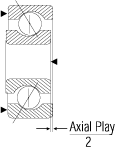| Available Bearings | Bearing Selector | Technical Info | New Products | |||
Ball Bearing Radial and Axial Play || Dynaroll
TECHNICAL INFORMATION
TECHNICAL INFO
Overview & Nomenclature
Materials
Cages/Retainers
Shields and Seals
Ball Bearings - Geometry
Ball Bearings - Tolerances
Ball Bearings - Lubrication
Load Rating and Bearing Lifetime
Ball Bearings - Torque
Ball Bearings - Noise
Mounting and Fitting
Assembly Preload
Ball Bearing Handling
Adhesive Practices
Assembly Characteristics
Useful Conversions
Interested in Mechanical Assemblies?
 Visit our Assemblies Section
Visit our Assemblies Section
Read our Quality Policy
Overview & Nomenclature
Materials
Cages/Retainers
Shields and Seals
Ball Bearings - Geometry
Ball Bearings - Tolerances
Ball Bearings - Lubrication
Load Rating and Bearing Lifetime
Ball Bearings - Torque
Ball Bearings - Noise
Mounting and Fitting
Assembly Preload
Ball Bearing Handling
Adhesive Practices
Assembly Characteristics
Useful Conversions
Interested in Mechanical Assemblies?
Read our Quality Policy
RADIAL AND AXIAL PLAY
Bearings are assembled with a slight amount of looseness between the balls and the raceways. This allows the bearing to rotate smoothly but also affects the performance of the bearing in a given application. This looseness can be split into two components - radial and axial play.
| RADIAL PLAY is the maximum displacement that one bearing ring can be displaced relative to the other ring in a direction perpendicular to the axis of rotation of the bearing. Radial play = ∆r |
 |
| AXIAL PLAY, or end play, is the maximum relative displacement of the bearing rings, in a direction parallel to the axis of rotation. Axial play = ∆a |
 |
Radial and axial play are interdependent and are determined during the manufacture of the bearing. Typically, radial play is a purchasing specification.
Standard radial play ranges and applications
Dimensions in .0001 inch (.001 mm)
Standard radial play ranges and applications
Dimensions in .0001 inch (.001 mm)
| DYNAROLL
CODE |
DESCRIPTION |
RADIAL
PLAY RANGE |
APPLICATION |
|
| MIN |
MAX |
|||
| MC2 |
Tight |
1 (3) |
3 (8) |
Low backlash gear systems with predominantly
radial loading. |
| MC3 |
Standard |
2 (5) |
4 (10) |
Low Speed electric motors. |
| MC4 |
Standard |
3 (8) |
5 (13) |
Gears, belt drives, tape guides, synchros,
servos. |
| MC5 |
Loose |
5 (13) |
8 (20) |
High speed electric motors, tape guides,
radial and axial loading. |
